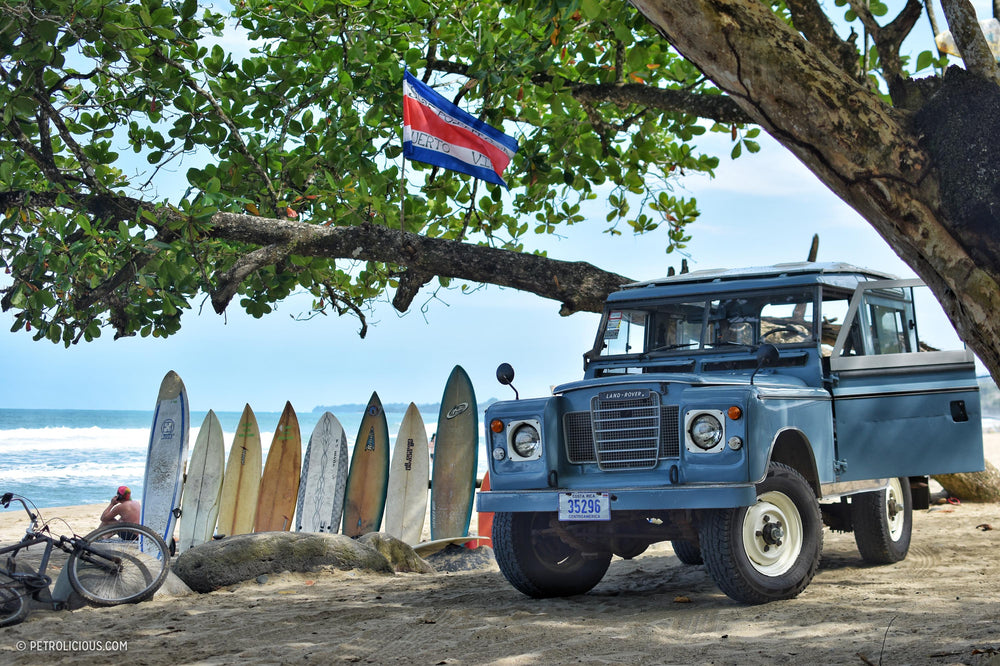I have been traveling for about three quarters of a year now, non-stop, going through Cuba, Mexico, Guatemala, Honduras, El Salvador, Nicaragua, Costa Rica, and currently, Panama.
Since leaving Mexico and bringing my VW Beetle photos with me, I did not have the opportunity to shoot that many more classic cars in South and Central America. However, a few weeks ago I met a trio of classic Series Land Rover owners in Puerto Viejo, Costa Rica.
The vibe of the village is very laid back, as you might have already guessed from these scenes by the beach. Puerto Viejo is located on the Caribbean sea, near the border to Panama. People come here for all sorts of reasons an activities, cycling along the beach, going surfing, or just laying down on a towel to soak it in under the wispy shade of palm fronds.






The people I met here call that lifestyle "Pura Vida,” which can be translated as a pure and rich life—not in terms of material wealth of course, but to be able to enjoy the present moment. As you probably know or can guess, Costa Rica is highly regarded for its incredible biodiversity, which is preserved in the country’s national parks, but also on display everywhere else you look. Between the lush jungle and the postcard beaches one is spoiled for choice when exploring the country. The Caribbean food is a similar story—all delicious, but only so much room in your belly for jerk chicken, rice and beans, seafood, all manner of dishes with coconut milk, plantains, and the sweets too. They have coconut and ginger cakes for example that added a few pounds to my scale.
But let’s get back to the Land Rovers at hand.



One evening by the beach I saw a blue two-door (a series 2A), so naturally I struck up a conversation with Fred, the owner. He works as a tour guide and uses this car for his business—an appropriate steed for exploring this often wild environment. We agreed to spend some time to shoot the car in the next days, so we’ll come back to him soon. The day after we’d met, I was in the town center running some errands when I saw another 2A, this time in a lovely shade of green somewhere between Campagnolo and military.




This vehicle looked pristine, so I took few shots of it as it was parked and then went to find and chat with the owner, Wendell Bell. A Canadian car collector now retired and living in Costa Rica, he kindly parked the car by the beach for me to shoot some better scenes of it. Back in Canada he keeps a ’64 Ford Thunderbird, a ’67 Jaguar XKE, and an ‘80 Mercedes-Benz 350SL—in other words, a diverse group.
He explained me that the parts that make up these old Land Rovers used to be built in Solihull, Warwickshire, in England, which were then sent to Costa Rica to be assembled into drivable trucks near San José. His example is from 1967, and since he acquired it roughly four years ago, he’s overhauled most of the systems of his truck; electrical components, hydraulics, etc.




Now, he tells me, he wants to re-do the suspension setup and then get to work on the interior. Retired? Yes. Idle? Surely not.
Two days later, I met up with Fred, the owner of the blue Series 2A mentioned earlier. I learned that Fred is originally from Washington D.C., and he lived in Venice, California before moving down to Costa Rica. He is the owner of five other Land Rovers at the moment, but the one that he presented to me is his most advanced project of the bunch. It is 1970 Series 2A, and though it has a few rough edges, it runs like a top—the engine was rebuilt six months ago, for starters.






Asking the question of how all this came to be, he told me that back in 2005 he’d wanted to buy a modern Land Rover Discovery (a 2001 model), but that after a second viewing, he decided ultimately not purchase it. He listened to his intuition, there was something wrong with it, so the search would have to continue. However, on the drive back home, he saw the blue Land Rover pictured here going traveling in the other direction. His eyes flashed on it, and he saw a sign stuck to it: "For Sale.” Fred did a U-turn to follow the driver, naturally.
After playing hide and seek for a while, he finally found the car parked nearby and talked to the owner. He bought it in cash right there with the money that he’d brought for the Discovery.

Since then, he has been using the car and working as a tour guide in Puerto Viejo for the last 12 years. Fred drives the people around in this superb vehicle to show them the various waterfalls, beaches, jungles, or to just cruise around with guests along the Caribbean coast.
He took me along for a little drive, and everyone that we met along the way knew him like an old friend. People were waving at us everywhere we went, and it seems that Fred is famous for his energy and enthusiasm—surely driving around a car like this doesn’t hurt that image!
We stopped first on Playa Cocles, a popular surf beach where people hang out the whole day in the water and in the sand. In the evening they practice some slack line, volleyball, or play music with each other. The setup was straight from a travel brochure: the surfboards stabbed into the sand in a row, the Costa Rican flag strung up in the palms, the undulations of the bright blue sea…





Afterwards, I asked him to drive us to a more rocky and jungle-like environment. We went to a backroad that fit the description to take another round of photos in a totally different environment than the one we’d left earlier in the day. We finished the session in front of a hostel where he parked the car right behind a late-model Defender. A branch of the family manifested in parallel parking.


For my last day in Puerto Viejo, I hired a bike to cycle to Punta Uva and had a good surprise when I saw another iconic Land Rover parked between the trees in front of the sea. The owner of this big beast is Erik Macor, an Italian from Venice. He has been living in Costa Rica for seven years now, and acquired the car about two years after moving here.






It’s a Safari 109 Series 2A from 1971. The engine has been changed to a diesel unit, and the gearbox is borrowed from a Toyota Land Cruiser BJ40. He wants to do the whole gamut of maintenance and mechanical refreshing before starting to use it as a tour guide like Fred.

The length of this Safari makes it quite unique looking even among its own kind, and the sandy color and white details fits the locale perfectly, so I’m sure this long rig will carry plenty of sightseers around in due time.
I am very grateful to Fred, Wendell, and Erik for their time—it was a pleasure meeting you all, may it happen again someday.























































